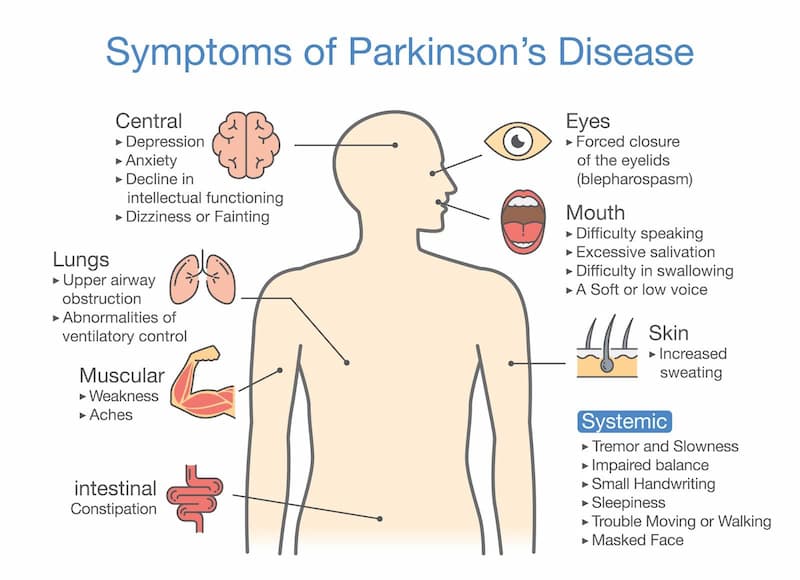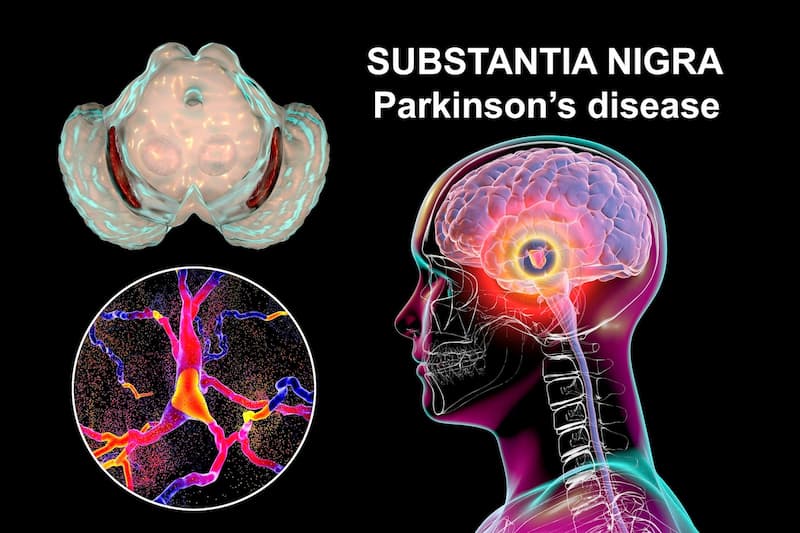Parkinson’s disease is a progressive neurological condition in which movement control is affected. Symptomatic management is the usual care that is usually given to treat this disorder as far as traditional therapies are concerned.
But in recent times, Parkinson’s treatment with stem cells has become an alternative choice for patients. This approach seeks to harness the growth power of such stem cells and thus enhance the quality of life of these people while slowing down the progression of the ailment.

Why Use Stem Cells to Treat Parkinson’s Disease?
Parkinson’s disease is a neurodegenerative disorder; therefore, it presents as a continuous breakdown of neurons. The unique ability of stem cells to generate various types of cells makes them a preferable option for alleviating Parkinson’s disease symptoms.
There are neurotrophic factors that stem cells often release when needed. These are proteins responsible for making sure that neurons survive, grow normally, and operate as they should.
Furthermore, they prevent other neurons from dying off totally and instead have a chance to work again, which means restoring some of their functions. That’s why stem cell therapy for Parkinson’s disease looks so attractive.
Moreover, stem cells have anti-inflammatory and immunomodulatory functions. Inflammation and immune system abnormalities usually follow Parkinson’s disease progression. Thus, by affecting these reactions, Parkinson’s treatment with stem cells can help create an environment more conducive to the survival and function of neurons.
Finally, stem cells stimulate a process known as neurogenesis, within which new neurons are formed. Meanwhile, Parkinson’s disease hampers the brain’s capability to produce neurons. As such, Parkinson’s treatment with stem cells promotes the growth of new neurons (improving this ability), which in turn leads to mending broken neuronal networks. Therefore, stem cells help Parkinson’s disease patients get a better quality of life.
What Are the Benefits of Stem Cell Therapy for Parkinson’s?
Stem cell therapy for Parkinson’s offers numerous advantages that include:
- Improved movement;
- Protection from neurodegeneration, which is characteristic of Parkinson’s disease;
- Slow down the progression of the disease;
- Reducing inflammation;
- Boosting neurogenesis;
- Better quality of life for patients;
- Minimal invasiveness of the treatment.
Get a free online consultation
Contact us to learn about the expected results of the treatment, its cost and duration.

Medical Advisor, Swiss Medica doctor
What Types of Stem Cells Can Treat Parkinson’s Disease?
Parkinson’s disease can be treated using many categories of stem cells, each with unique strengths and weaknesses. Here are various types of stem cell therapy for Parkinson’s disease:
Mesenchymal stem cells for Parkinson’s disease
These are stem cells capable of changing into many cell types, obtained from various sources like bone marrow, umbilical cord, and fat. MSCs are known for inhibiting inflammation and modifying immune responses; they hold promising prospects for managing Parkinson’s disease symptoms. At Swiss Medica, we primarily use mesenchymal stem cells for Parkinson’s disease due to their safety and efficacy.
Neural stem cells for Parkinson’s disease
Neural stem cells are specialized cells that have the ability to transform into neurons and other types of brain cells. In practice, we harvest them from MSCs. In fact, neural stem cells for Parkinson’s disease stimulate to repair neurons in the brain, potentially slowing disease progression.
Embryonic Stem Cells (ESCs)
ESCs are isolated from embryos at a very early stage when they are still pluripotent; they can give rise to any cell type in the body. Despite the effectiveness of Parkinson’s treatment with stem cells, it is not ethical to use those cells because they are recovered from aborted fetuses.
Induced Pluripotent Stem Cells (iPSCs) are being studied for their potential to make treatments more personally tailored. These cells are developed by reprogramming adult cells to become pluripotent in such way that they can change into any cell type. Induced pluripotent stem cells. Now iPSCs are not used for the treatment but for the research purposes.
Embryonic Stem Cells Treating Parkinson’s Disease
Embryonic stem cells (ESCs) have the remarkable potential to differentiate into any cell type, including dopamine-producing neurons. This makes embryonic stem cells treating Parkinson’s disease a theoretically attractive option. However, there are several concerns associated with their use:
1. Ethical issues
The use of ESCs involves the destruction of embryos, which raises significant ethical concerns. Many patients and researchers prefer to avoid Parkinson’s treatment with stem cells to prevent such ethical dilemmas.
2. Risk of tumors
Parkinson’s treatment with stem cells carries a risk of both benign and malignant tumors. ESCs have a higher propensity to form tumors due to their nature, which makes them highly proliferative and capable of forming teratomas (tumors composed of various tissue types).
Stem Cell Therapy is One of the Latest Parkinson’s Disease Treatments
Stem cells helping Parkinson’s disease is considered one of the latest ways to manage the disease. Stem cell transplants for Parkinson’s are aimed at managing symptoms by restoring damaged neurons and safeguarding the available ones.
Giving stem cells in Parkinson’s disease treatment is simple through methods such as intrathecal injection and intravenous infusion, which do not involve surgery. These techniques were intended to enable large numbers of stem cells to reach affected areas with the minimum of hazards and recovery time.
In general, stem cell transplant for Parkinson’s represents a hopeful and advanced therapy for Parkinson’s disease, bringing hope to patients looking for options other than traditional care methods.
Side Effects of Stem Cell Therapy for Parkinson’s Disease
Although Parkinson’s disease stem cell therapy is usually considered to be safe, there are potential side effects of which you should be aware. However, most of them are short-term and controllable:
- Temporary presence of fever
- Injection site reactions such as mild inflammation
- Slight risk of infection associated with any medical procedure.
- Tumor formation: In contrast to embryonic stem cells, MSCs can’t produce any tumors, but if someone has cancer already during treatment, the rate at which cancer cells spread may increase. Therefore, patients with active cancer should not undergo the treatment with stem cells.
- Headache or nausea
As a whole, the side effects of using stem cells in Parkinson’s disease treatment are fairly small-scale and short-lived, heightening its attractiveness as an alternative therapy to many patients.
Best Stem Cell Clinic for Parkinson’s Treatment with Stem Cells
Choosing the best stem cell clinic for Parkinson’s treatment is a crucial decision that can significantly impact the outcomes of the therapy. Look for clinics with a proven track record in Parkinson’s disease and stem cell transplants.
Evaluate the clinic’s treatment protocols, including the types of stem cells used, administration methods, and comprehensive care plans. Positive experiences and outcomes from other patients can be a good indicator of the clinic’s quality of care.
Ensure that the clinic adheres to regulatory standards and guidelines for stem cell therapy.
At Swiss Medica, we pride ourselves on meeting these criteria and providing high-quality Parkinson’s treatment with stem cells. Our experienced medical team, personalized treatment plans, and commitment to patient care make us a leading choice for individuals seeking innovative treatments for Parkinson’s.
Why Choose Swiss Medica for Stem Cell Therapy for Parkinson’s?
Swiss Medica offers several compelling reasons for choosing our clinic for managing Parkinson’s disease and stem cell transplants:
- Expert medical team with deep knowledge in regenerative medicine and Parkinson’s treatment with stem cells;
- Advanced treatment protocols that comply to strict guidelines;
- Comprehensive care, including travel assistance and medical guidance;
- Patient-centered approach, including pre-treatment and after-treatment care;
- Positive feedback from our patients reporting improvements after therapy;
- Ethical and safe practices, which includes the use of adult mesenchymal stem cells;
- In-house laboratory providing active stem cells;
- Rigorous quality control at every step of the production of cells and therapy procedures, ensuring the highest standards of safety and efficacy.
Choosing Swiss Medica for stem cell therapy for Parkinson’s disease means choosing a clinic dedicated to innovation, patient care, and achieving the best possible outcomes.
The Success Rate of Stem Cell Therapy for Parkinson’s Disease at Swiss Medica
We have observed that using Parkinson’s treatment with stem cells has resulted in up to 80% of Swiss Medica patients reporting improvements. We are able to record this success rate because we screen stem cells helping Parkinson disease carefully, carry out tests before using them for the treatment, and provide personalized care plans that best suit individual needs. Our competent doctors and nurses accompany patients throughout their stay at our clinic.
It should also be noted that there may be a difference in individual results for Parkinson’s and stem cell treatment.
Real Patient Stories
These are testimonials that highlight the personal experiences and outcomes of individuals who have undergone the treatment. Here are a few examples:
Carlo G., a patient from Italy
I was at all the best clinics, but none of them gave me the results like the ones I got after only 3 days in the Swiss Medica clinic.”
Carlo is a patient from Italy who came to Swiss Medica in order to undergo stem cell therapy for Parkinson’s, which had been diagnosed six years prior to his visit to the clinic. He stayed in the facility for three days as he was attended to.
He noticed improvements in the symptoms and received no side effects during the treatment. Carlo was able to understand the procedure due to the detailed explanation from the medical team, whom he emphasized as being helpful and professional in administering stem cells without causing pain or any form of sickness.
Francesco, a patient from Italy
“I can talk faster, write, walk in the mountains, wash by myself, and play football with my grandchildren.”
Francesco, an Italian patient, came to Swiss Medica’s Belgrade clinic for stem cell treatment for his Parkinson’s disease after a period of nine years. The disease was manifested by stiffness in muscles, sluggish movements, and an inability to balance the body.
Parkinson’s treatment with stem cells improved his memory and other functional capabilities while restoring confidence in daily living within a six-week period only.
Can Stem Cell Сure Parkinson’s Disease?
Parkinson’s disease is a complex and progressive neurological disorder with no cure. Some patients believe in Parkinson’s disease stem cell cure but our medical experts explain that this condition is incurable. Stem cells come with numerous benefits, including symptom relief, slowed disease progression, improved functions, and independence from medications in terms of improving quality of life for those affected by it.
Stem Cell Parkinson’s Treatment Cost
The stem cell Parkinson’s treatment cost can vary widely depending on several factors, including the type of stem cells used, the specific treatment protocols, and the patient’s individual needs. At Swiss Medica, the cost of treatment typically ranging from €7,000 to €31,000*.
You can book a free consultation with our experts to understand the specific stem cell Parkinson’s treatment cost for your personalized treatment.
*The prices mentioned are indicative and subject to change based on individual factors, including the condition’s severity and the number of stem cells needed. Prices are valid as of January 2025.

Stem Cell Research for Parkinson
The field of stem cell cure for Parkinson’s disease research is rapidly changing, with a lot of studies and clinical trials designed to help us better comprehend and use this new treatment method. Some areas of research include studies on how to make stem cells change into dopamine-producing neurons, which are, in turn, connected to other neural circuits. Also, studies aim to determine whether stem cell therapy might be integrated into other treatments, such as gene therapy, neuroprotective agents, and physical rehabilitation.
A lot of research has aimed at defining the individual factors responsible for processes such as neuroprotection or even neurogenesis, as well as inflammation modulation. From a broader perspective, stem cells may hold key solutions for Parkinson’s disease, presenting an entirely new outlook that would change how it’s dealt with.
Parkinson’s Stem Cell Treatment Clinical Trials
Clinical trials play an essential role in pioneering efforts to advance the potential of Parkinson’s disease stem cell cure. They assess the safety, efficacy, and potential benefits of different types of stem cell treatment in a controlled and systematic manner.
Clinical trials usually involve several phases:
- Phase I involves safety and dosage evaluations;
- Phase II involves efficacy and side effects assessment;
- Phase III involves confirmation of efficacy and monitoring of side effects.
The selection of participants in clinical trials is very careful based on specific criteria such as the stage of the disease, general health condition, and previous treatments.
Trials could test different stem cell types, dosages, and administration pathways to identify the most efficient methods. This also concerns comparisons between autologous and allogeneic cell types and investigation into different ways of their transportation.
What’s the Outlook for Stem Cell Therapy for Parkinson’s?
The future of Parkinson’s disease and stem cell transplant is bright as more studies are conducted and show promising results. Several factors make such an optimistic prospect possible. Some of these are as follows:
- Progression in the field of stem cell research
- Ongoing clinical trials and studies
- Customized medicine for individuals
- Combining different treatment methods
- Provision of regulations
Although there is still a lot to be known and done about it, stem cells helping Parkinson disease’s future is very positive.
Frequently Asked Questions about Parkinson’s Disease Stem Cell Cure
1. What is stem cell therapy for Parkinson’s disease?
Stem cell therapy involves the use of stem cell transplant for Parkinson’s disease to replace lost dopamine-producing neurons, protect existing neurons, and promote the regeneration of neural circuits. Therapy involves such procedures as harvesting the cells from the donor or the patient, cultivation and differentiation of these cells, infusion of these cells back to the patient, and monitoring the results. It should be noted that Parkinson’s disease stem cell cure is not possible, but stem cell therapy offers many advantages. Potential benefits include symptom relief, improvements in motor function, slowing down disease progression, and reduced medication dependence.
2. How long does it take to see results from stem cell therapy?
The timeframe for seeing results from stem cell therapy can vary depending on the individual patient and the severity of their condition. In many cases, patients experience improvements just after the stem cell treatment. Some patients may notice improvements within weeks, while others may take several months to experience significant benefits.
3. Is stem cell therapy covered by insurance?
Usually, stem cell treatment is not covered by medical insurance. However, it may depend on the provider and the specific insurance plan. It is recommended to consult with your insurance company to determine if stem cell therapy for Parkinson’s disease is covered.
Contact us
You can contact our Medical Advisor to find out about the expected results of stem cell treatment according to your case, its cost, duration, and some other details.

Medical Advisor, Swiss Medica doctor
List of References
Han F, Hu B. Stem Cell Therapy for Parkinson’s Disease. Adv Exp Med Biol. 2020;1266:21-38. doi: 10.1007/978-981-15-4370-8_3. PMID: 33105493.
Stem Cell Therapy for Parkinson’s Disease. 2021 Mar 11 https://www.startstemcells.com/parkinson-disease-treatment.html
Björklund LM. Stem cell therapy for Parkinson’s disease. Dialogues Clin Neurosci. 2004 Sep;6(3):303-11. doi: 10.31887/DCNS.2004.6.3/lbjorklund. PMID: 22033634; PMCID: PMC3181808
Stem cell therapy for Parkinson’s disease. 2023 September 6, https://www.medicalnewstoday.com/articles/stem-cell-therapy-for-parkinsons
Stem Cell-Based Therapies to Treat Parkinson’s. 2023 October 27 https://www.parkinson.ca/stem-cell-based-therapies-to-treat-parkinsons/
Parkinson’s Disease https://hsci.harvard.edu/parkinsons-disease-0
Medical Advisor, Swiss Medica doctor








